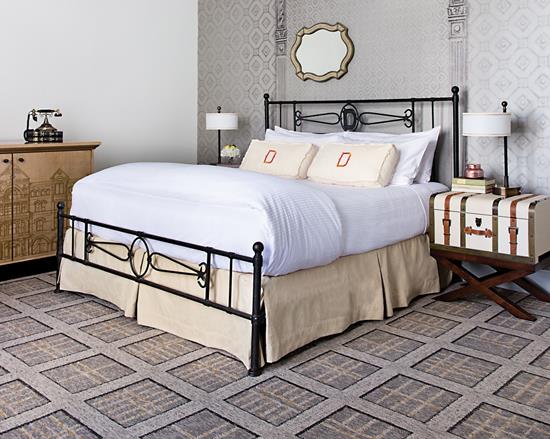Designer Forum: Rottet Studios tells a bold, historic tale with its Driskill Hotel design - Nov 2017
By Christopher Evans
The Driskill Hotel is a storied, larger-than-life hotel in Austin, Texas. Rottet Studio was approached to help tell the Driskill story in a renovation of the main lobby, café and the guest floors. Built in 1886 by wealthy cattle baron Jesse Driskill, this hotel redefined luxury in the town, prior to the completion of the state capitol. It may have been ahead of its time in the “Wild West” town, but the hotel persevered, its fortunes rising and falling through the years, along with those of the city as a whole. Any hotel with that duration of life has a lot of stories to tell, such as President Lyndon B. Johnson’s first date with his wife or the story of a young girl who haunts the hotel. Stories like these populate the Driskill like the furniture.
BROADLOOM SETS THE STAGE IN THE LOBBY
Since Rottet Studio does not specialize in historical renovation, the angle of the renovation story is through the lens of the present, looking back through the windows of time. This perspective maintains the authenticity of a Texas tall tale and the remembrances polished by retelling. These layers allowed the design team the freedom to blend the past and the present, creating a more honest project.
The story of the hotel grows from the Gilded Age, an era perfect to reinforce the lofty goals of the Driskill at its founding. The carpet, upon entering, begins with the story of a local debutante and her lost jewelry. Inspired by imagery of broaches, pearls and rings, Rottet sampled the intricate patterns in the grand lobby. Patterns were drawn and scattered throughout the floor, separated like rugs in each seating area. The intricately designed carpet-used alongside the existing marble in the main lobby-was chosen for a couple of reasons. The sheer volume of the grand lobby, combined with the expanse of existing marble there, required carpet to soften the acoustics in the space, especially during the many events that take place there. Equally important, the transition from hard surface to soft surface intuitively implies a separation from circulation to congregation.
A primary goal for hospitality projects like the Driskill is to evoke a specific emotional response to the spaces. Carpet is a versatile way to sculpt these emotions. The extensive color range and patterning ability provides an almost limitless avenue of expression. Specific colors evoke certain emotional responses. With that in mind, shades of violet and platinum were chosen to dominate the color palette in the carpet because they typically evoke a sense of royalty, nobility and ceremony. These colors supported the luxury and bigger-than-life feel that the renovation needed in order to tell a rich story.
Axminster carpet by Ulster was chosen for a few reasons. Axminster carpets lend themselves to complex and unique patterns, and the jewelry-influenced design required a material that could respond to the complexity and fine details of the project. Performance was paramount. The high traffic lobby is often reconfigured for events, requiring a durable yet sophisticated carpet to withstand the impact.
BUILDING OUT THE STORY WITH FINISH MATERIALS
Elevators regularly take more abuse than most other spaces due to the concentration of use, so porcelain tile was chosen to respond to the durability requirements. The elevator cab sources from a bygone era, when the freedom of automobile travel was still new and exciting. The porcelain tile selected was a beige tile cut into a parquet pattern. This fit into the design of the luxury-automobile-inspired cab. Honey-colored cork panels create a wainscot at the base of the cab with tufted leather panels lining the balance. Tile selection is important for high-caliber hotels like the Driskill. Authenticity was key to continuing the story of this hotel, and care was taken to be honest with the guest and to use materials genuinely. There is a growing preference for porcelain tile that is not just a facsimile of another material, like wood or stone, but rather a tile that is nothing but a tile. Tile is a real thing with a long history in construction. The digital technology of porcelain tile fabrication is being harnessed to create beautiful patterns and textures that stand alone as porcelain.
Guest corridor floors continue a similar Axminster carpet pattern influenced by jewelry. Subtle wayfinding concepts were integrated into the carpet at important intersections in the complex corridors of the 131-year-old property.
The detail flexibility of the Axminster gives way in guestrooms, where a subtle textured pattern is captured using broadloom by CM Hospitality. A sense of place is paramount in many hotels today, especially one as legendary as the Driskill. This was incorporated by developing a complex pattern formed from a layering of regional images to develop the guestroom carpet. A complex textured grid pattern was created using multiple historic maps of Austin in the 42-ounce broadloom product. One map from 1886 captures the general city grid and key features, like the future site of the state capitol and the location of the hotel, and it is overlaid with a more complex building map from the 1920s. These two maps, combined through a mixture of cut and loop pile, created a layered pattern that purposefully obscures the actual identification of a map. Like many of the legends and stories that populate the hotel, some guests will walk over the carpet without realizing it is a map, while others will slow down to identify the Texas capitol in the pattern. This supports the goal of evoking a specific emotional response with grace and subtlety.
Floor design is critical to the success of any project and can often be one of the most challenging. Sourcing materials that combine all the challenges of storytelling, the product performance and programming have to be carefully considered and executed.
Copyright 2017 Floor Focus
Related Topics:Rottet Studio
